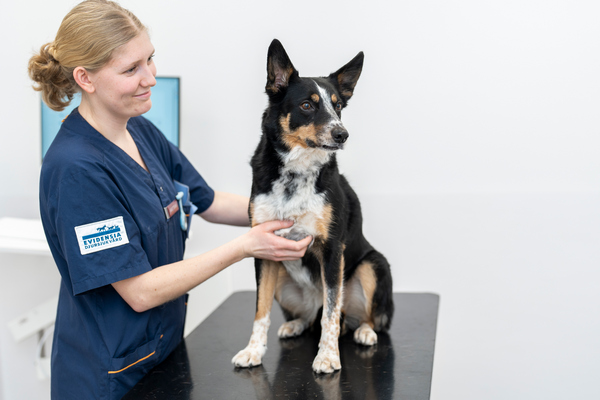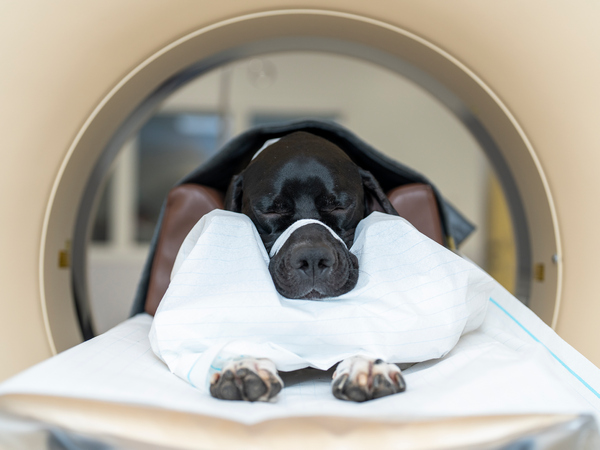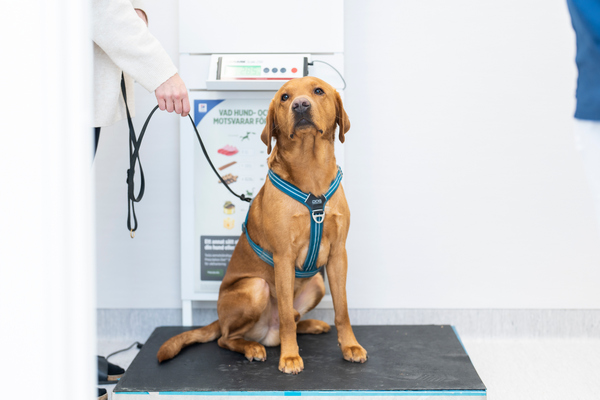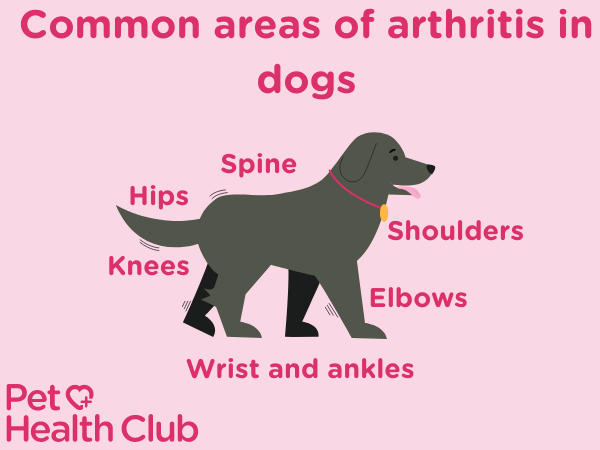Arthritis in dogs: signs, symptoms and treatment
If your dog is reluctant to exercise or play and takes longer to get going in the mornings, it may be a sign of arthritis.
This condition can leave your dog unwilling to go for their daily walks because they're uncomfortable and have difficulty moving in the easy way they used to. A dog with arthritis is often stiffer, slower, and more irritable, because they suffer constant joint pain.
Thankfully, there are ways to manage arthritis in dogs, and relieve your pet's pain.
What is arthritis in dogs?
The suffix 'itis' means inflammation, and arthritis simply means inflammation of the joints. Canine arthritis is a common problem – particularly in older dogs – that can worsen over time and has no cure. It mainly affects the cartilage, a smooth, slippery tissue that covers the ends of bones where they form a joint. Cartilage helps the joints move easily and acts as a shock absorber.
What causes canine arthritis?
Age
As dogs age, cartilage regrowth slows down, and the overall strength of the joint structures deteriorates. This age-related wear and tear of the protective cartilage layer can lead to the gradual onset of arthritis. Senior dogs often experience this due to the deterioration of their joints over the years.
Breed
Some dog breeds are more likely to develop arthritis because of their size and body structure. Larger breeds like Labradors, German Shepherds, and Golden Retrievers are particularly at risk because their large builds place greater stress on their joints.
Weight
Weight plays a major role in the development of arthritis. Overweight and obese dogs are at a higher risk because the extra weight puts more stress on their joints. This can speed up the wear and tear process of cartilage in the joints, leading to inflammation and arthritis.
Activity and Injury
Dogs that are very active or have been involved in intense physical activities may be more prone to arthritis due to greater strain on the joints. Repetitive stress from activities like jumping or high-impact play can contribute to the earlier development of joint issues.
Similarly, those dogs who have suffered from injuries such as ligament tears or fractures affecting the joint will be more susceptible to arthritis in the affected joint, even if the injury has healed well.
Genetics
Genetic factors can also influence the likelihood of a dog developing arthritis. Some genetic traits can lead to poor joint conformation. For instance, some breeds may inherit a tendency for hip dysplasia. In this condition, the hip joint doesn't develop properly, which is likely to lead to arthritis later in life.
The development of arthritis in dogs
Cartilage breakdown
In a healthy dog, the cartilage is regularly rebuilt as it wears down. However, as the dog ages, the cartilage might wear away faster than it can be replaced.
Inflammation
When the cartilage wears down, the bone edges beneath become exposed and rub against each other. This friction can cause joint pain and swelling, which is the inflammation commonly seen in arthritis.
Bone changes
Over time, constant rubbing and inflammation can lead to changes in the bone itself, such as the development of bone spurs around the joint, causing further discomfort and restricted movement.
Signs of arthritis in dogs
Stiffness and discomfort are likely the first hints that your dog may develop arthritis. The signs of canine arthritis tend to appear gradually and become increasingly worse.
- Stiffness, especially after rest
- Intermittent lameness
- Reluctance to move or go for usual walks
- Swollen and painful joints
- Inability to perform activities that they were previously able to, such as go up or down stairs, or jump onto the sofa
- Lethargy and increased sleeping
- Unable to get comfortable when resting
- Weight gain
- Irritability and depression
- Loss of appetite

How will a vet diagnose canine arthritis?
Physical exam
Your vet will examine your dog's movements, check for joint swelling and feel the limbs and joints to detect warmth, pain, or reduced movement. Your vet might also check your dog's muscle condition, as arthritis can sometimes lead to muscle atrophy due to decreased activity.

Discussion of symptoms
Your vet will ask you about any symptoms you've noticed in your dog, such as difficulties getting up, reluctance to jump or climb stairs, or any signs of pain like whimpering or changes in behaviour.
X-rays
These are some of the most common diagnostic tools for arthritis. X-rays can show swelling, changes in the space within the joint, signs of bone degeneration, or the presence of bone spurs.
Ultrasound, MRI or CT scans
These imaging methods are less common but can be used to assess soft tissues around the joints, like ligaments.

Joint fluid analysis
This test involves taking a small fluid sample from within a joint to look for signs of inflammation and rule out other conditions, such as infections or gout.
Medication trial
Your vet might prescribe a short course of anti-inflammatory medications to see if there's an improvement in your dog's symptoms, which can help confirm arthritis is present.
Other tests
If your vet suspects an underlying condition is causing the joint problems, they might do blood tests to check for signs of infection or autoimmune diseases.
Treating arthritis in dogs
Arthritis can't be cured, so treating it in dogs involves reducing pain, preserving joint function, and improving quality of life.
Pain relief medication
There are various painkillers used for dogs with arthritis. Non-steroidal anti-inflammatories (NSAIDs) are commonly prescribed to help reduce joint inflammation and pain. However, they can have side effects, especially with long-term use, so only use them as directed by your vet. There are also other pain relief medications that can be used if your dog cannot tolerate NSAIDs, or sometimes in combination as the disease progresses.
Monoclonal antibodies
There is now an monthly injectable medication available that inhibits the nerve growth factor associated with pain in arthritis.
Supplements
Glucosamine and chondroitin are popular supplements that may help maintain cartilage health and reduce joint inflammation. Omega-3 fatty acids, often given as fish oil supplements, can also help reduce joint inflammation.
Weight management
If a dog is overweight, reducing their weight can significantly decrease the stress on their joints. A healthy diet and appropriate exercise are key.

Exercise modification
Regular, gentle exercise helps keep the joints moving and muscles strong. Avoid activities that strain the joints, like jumping or running on hard surfaces. Swimming is an excellent, low-impact exercise for dogs with arthritis. If your dog loves chasing balls, consider swapping them out for a ‘scent-hunt’ with hidden treats.
Physiotherapy
Specific exercises might be recommended to keep the joints mobile and muscles strong.
Hydrotherapy
Exercising in water supports the dog's weight and reduces stress on the joints while allowing good movement and muscle building.
Massage and acupuncture
These can help manage pain and improve blood flow to the affected areas, increasing comfort and mobility.
Surgery
Surgical options such as joint replacement or corrective surgery might be considered in severe cases.
Comfortable bedding
A soft place to lie down can help alleviate pain from pressure points. Raising it slightly off the floor can also help your dog get up again afterwards.
Joint protectants
Boots or floor mats can help prevent slipping and cushion the joints from hard surfaces.
Preventing arthritis in dogs
Preventing arthritis in dogs starts when they're young. While it's not always possible to prevent it completely, you can help reduce the risk or delay the onset of symptoms.
Diet
Feed your dog a high-quality diet that's appropriate for their age, size, and activity level. Some diets are specially formulated for joint health and include supplements like glucosamine, chondroitin, and omega-3 fatty acids. Keep your dog at a healthy body condition by giving appropriate food portions and not overdoing the treats.
Regular, appropriate exercise
Exercise helps keep your dog's joints flexible and their muscles strong, which supports the joints. However, it's important to choose appropriate activities. Always consider your dog's breed and age when planning their exercise routine.
Avoid high-impact activities that involve a lot of jumping or sudden stops, which can strain joints. Instead, encourage regular, moderate exercise like walking or swimming, which are excellent for joint health without being too harsh.
Supplements
Adding joint supplements to your dog's diet could help maintain cartilage health and reduce inflammation. Always discuss any new supplements with your vet before starting them.
Regular veterinary check-ups
Regular check-ups can help catch early signs of joint wear and tear before they develop into arthritis. Your vet can also provide advice tailored to your dog's breed and risk factors.
Manage and monitor play and exercise
Ensure your dog doesn't overexert themself, especially during its puppy years when its joints are still developing. Provide them with soft landing surfaces and avoid hard, slippery floors where they can injure themselves.
Which dog breeds are at risk of arthritis?
Arthritis can affect any dog, but some breeds are particularly at risk due to their size, genetic makeup, and body structure. These dog breeds are commonly at higher risk of developing arthritis:
- Labrador Retrievers
- German Shepherds
- Golden Retrievers
- Great Danes
- Saint Bernards
- Dachshund
- Basset Hound
- Newfoundland
- Bulldogs
- Pugs
- Boxers
Regular vet check-ups can help catch early signs if you have a high-risk breed.
Can supplements help dogs with arthritis?
The evidence is very limited, but supplements may help dogs with arthritis by supporting joint health and reducing inflammation. However, they should be part of a treatment plan that includes proper diet, exercise, and possibly medications prescribed by your vet.
Common areas of arthritis in dogs

Arthritis can affect any joint in a dog's body. Still, certain areas are more commonly affected due to the stress and strain they endure.
Hips
Hip arthritis, or hip dysplasia, is common in dogs, especially in larger breeds. The hip joint is a ball-and-socket joint, and when it's not formed properly or wears down, it can lead to painful arthritis.
Elbows
Elbow dysplasia is a common cause of elbow arthritis, particularly in large breeds. This condition can lead to uneven bone growth in the elbow joint, causing pain and stiffness.
Knees
The knee joints are also susceptible to arthritis, often due to injuries to the cruciate ligaments, which is common in active dogs. Damage here can lead to instability and abnormal movement, eventually causing arthritis.
Spine
Arthritis can affect the vertebrae in the spine, leading to stiffness and pain. This is particularly seen in older dogs and certain long-bodied breeds like Dachshunds, who are prone to intervertebral disc disease.
Shoulders
The shoulder joint can develop arthritis, often due to repetitive stress or injuries. Like agility dogs, dogs that perform a lot of jumping or sharp turns are particularly at risk.
Wrists and ankles
Arthritis can also affect the wrists and ankles (carpal and tarsal joints). However, these areas are less commonly affected than the hips, elbows, and knees.
Have there been any studies into arthritis in dogs?
One study evaluated 62 peer-reviewed papers investigating various risk factors for canine osteoarthritis and its predisposing conditions, such as developmental joint dysplasias and cruciate ligament degeneration.
These studies examined modifiable (things that can be changed) factors like body weight and neuter status and non-modifiable (things that can't be changed) factors, including breed, sex, and age, to determine their impact on the likelihood of a dog developing arthritis. The research highlighted conflicting outcomes on some risk factors. It emphasised the need for a more detailed investigation better to understand the complex nature of arthritis in dogs.
Need more information on arthritis in dogs?
For expert advice on arthritis in dogs, contact your local vet.
Find your nearest vet using our Find a Vet page, or speak to a vet online using Online Vets.




